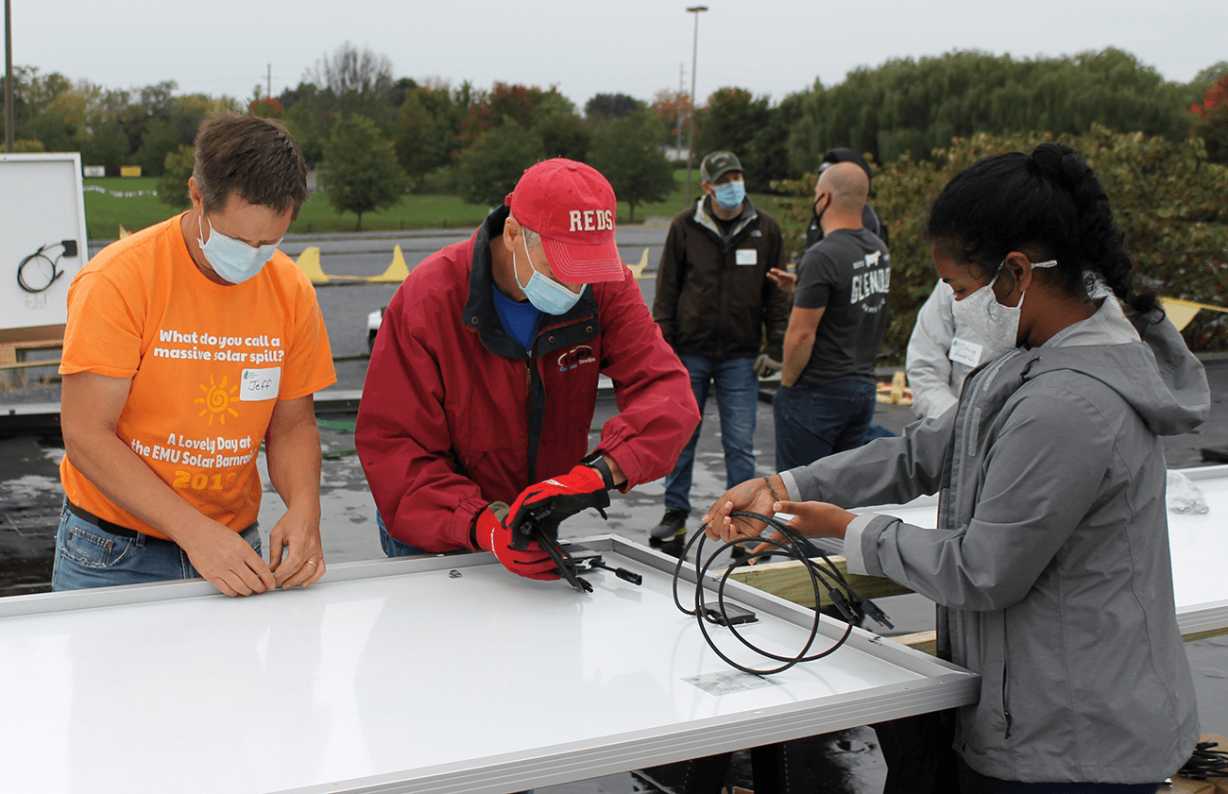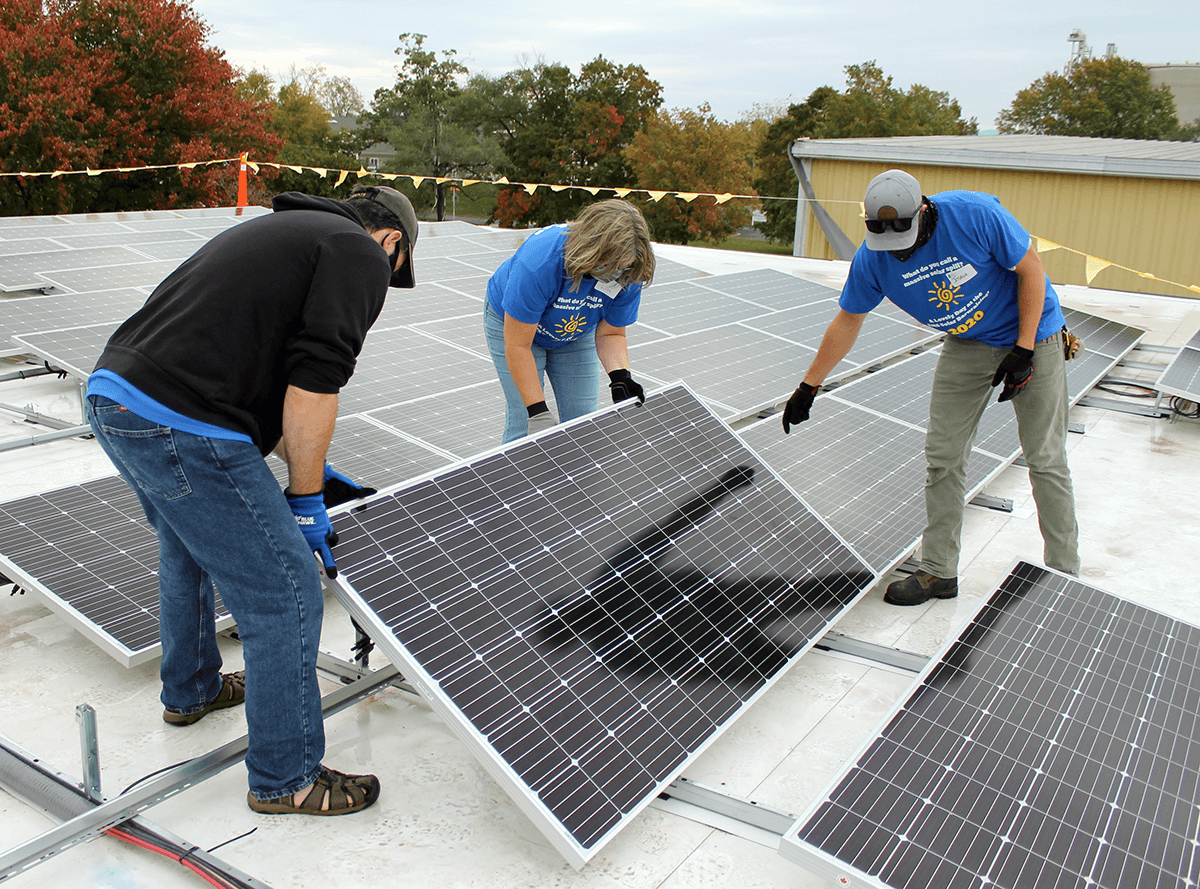
By Eric Gorton, contributor
An overcast sky and a few sprinkles Saturday didn’t dampen the spirits of volunteers and others who swiftly snapped 357 solar panels into place on the roof of Eastern Mennonite School.
The 136 kilowatt system — enough to run the equivalent of 15 average homes and avoid more than 141 tons of carbon dioxide pollution per year — will provide about a third of the school’s annual energy requirement for at least the next 20-30 years, said Paul Leaman, head of the school and one of the volunteer installers.
“Being a school, naturally we want the future generations to understand the importance of using renewable energies, the ability to do that, the science behind it,” he said.
Students at the school will have opportunities to see the array up close and monitor its output on computers.
“Our planet is getting taxed more and more with the number of people it’s trying to support,” Leaman said. “We want to plant seeds that will help sustain this Earth for many future generations.”
EMS teamed up with Staunton-based Secure Futures, LLC, to design and install the system. The project began last year when Secure Futures installed a new insulated roof on the school. The school received the solar energy equipment at no upfront capital cost through a 20-year agreement with Secure Futures. Over that term, Secure Futures will operate and maintain the system, providing services and support for the school to generate electricity at a cost lower than typically available from Harrisonburg Electric Commission.
In addition, Secure Futures will provide EMS with lesson plans and materials created by NEED (National Energy Education Development) for hands-on instruction and learning the importance of clean energy. Secure Futures had initially engaged with the Harrisonburg City Public Schools in a similar, though larger-scale project, but that deal fell through in 2019.

Just the latest of many solar projects
Secure Futures founder and CEO Tony Smith said the EMS project is a sign of the community’s continued movement toward renewable energy and called Harrisonburg, “Solar City, Virginia.” There’s more solar per capita in Harrisonburg than anywhere else in the state, he said.
“It’s either something in the water or something in the air,” he joked. “People in this community have really chosen to walk-the-walk in terms of sustainability, and today’s event is a great example of that.”
The Harrisonburg Electric Commission, which tracks the number of solar customers, has estimated that collectively, community solar projects generate enough power to cover 1 percent of total peak demand in Harrisonburg.
Volunteer coordinator Jeff Heie said 45 people volunteered to install the panels in four hours and 15 minutes on a grid that Got Electric, LLC, completed in June.
“To be honest, I was somewhat shocked that we were able to do it this quickly. We were a very efficient crew of volunteers,” he said.
Andy Hershberger, director of Virginia operations for Got Electric and a 2003 graduate of EMS, said the project is an example of the school practicing what it preaches.
“They talk about renewable energy in school and now they’re using it to power their classrooms, so I think it’s great,” he said.
The system will be operational in a few days, after all the electrical pieces are working together and it gets a final inspection, he said.
Having volunteers help install the panels is a “great awareness-raising tool,” Heie said. “A big reason for this is just exposing people to solar power, getting people interested and excited about it.”
Heie said the experience also helps demystify the technology.
“Anybody can do this, and the price of solar has just plummeted over the last decade,” he said. “One of the beauties of solar is, it’s very scalable. You can have one solar panel that is charging your power tools at home or you could have 400 solar panels that are powering your school. It’s a technology that’s accessible to anyone and everyone.”

It takes a village …
Volunteers worked in two shifts on the roof of the school, with the first scheduled from 8-11:30 a.m. The second shift was scheduled from 11:30 a.m.-2:30 p.m., but the job was done by 1;30, Heie said.
Volunteer duties included taking the panels off a boom lift that raised them from the ground to the roof and carrying them to sawhorses where other volunteers snapped on rapid shutdown devices, which are required by law to shut down solar systems in the event of an emergency. Once the shutdown devices were snapped in place, pairs of volunteers carried the panels, one on each end, to snap them into the rack that holds them in place.
All volunteers wore masks and had their temperatures taken before starting their shifts. They also answered a series of questions about how they were feeling and if they had been in contact recently with anyone diagnosed with COVID-19.
Among the volunteers was EMS senior Rahel Lema.
“It’s teaching me a lot about teamwork and community building and also the renewable energy part of it,” she said. “I think renewable energy is a great way to help our environment, and thinking long term about future generations, installing solar panels is a great way for our school to take that step.”
Volunteer Isaiah Mejah said he had never done anything like it and was happy to help. Having studied environmental advocacy in graduate school at James Madison University, Mejah said, “I am aware of what is happening and I thought it was a good cause to help out in the community. … seeing everybody come out, I think it’s really good.”
Lisa Farwell, recently employed by Secure Futures, came with her husband, Brad, and said it was her first project. “It’s exciting to see what I see in the office here in real life, and it’s just fantastic to see all these people out here too, making it happen. It makes you feel good,” she said.
City council candidate Charles Hendricks also volunteered and said he supports organizations in Harrisonburg that are “investing in their resiliency and caring for God’s creation through the use of clean energy.” He added that the solar energy sector is creating new, good paying jobs in the community and that there are “outstanding economic benefits for the school and the community with this solar PV installation.”
Secure Future’s Tony Smith said acceptance of solar has come a long way since he founded the company in 2010. After installing solar panels at Eastern Mennonite University and then working on a project at Washington & Lee University in the early years, the company received a cease and desist order from Dominion Energy.
“We had an abrupt wakeup call that in order to succeed, we had to change the laws,” he said.
Smith said he used to refer to Virginia as the dark state.
“In 10 years, there has been a huge transformation,” he said. “This year we saw passage of the Virginia Clean Economy Act, which is a landmark piece of legislation that really opens up the state for solar.”
Journalism is changing, and that’s why The Citizen is here. We’re independent. We’re local. We pay our contributors, and the money you give goes directly to the reporting. No overhead. No printing costs. Just facts, stories and context. We’re also a proud member of the Virginia Press Association. Thanks for your support.













